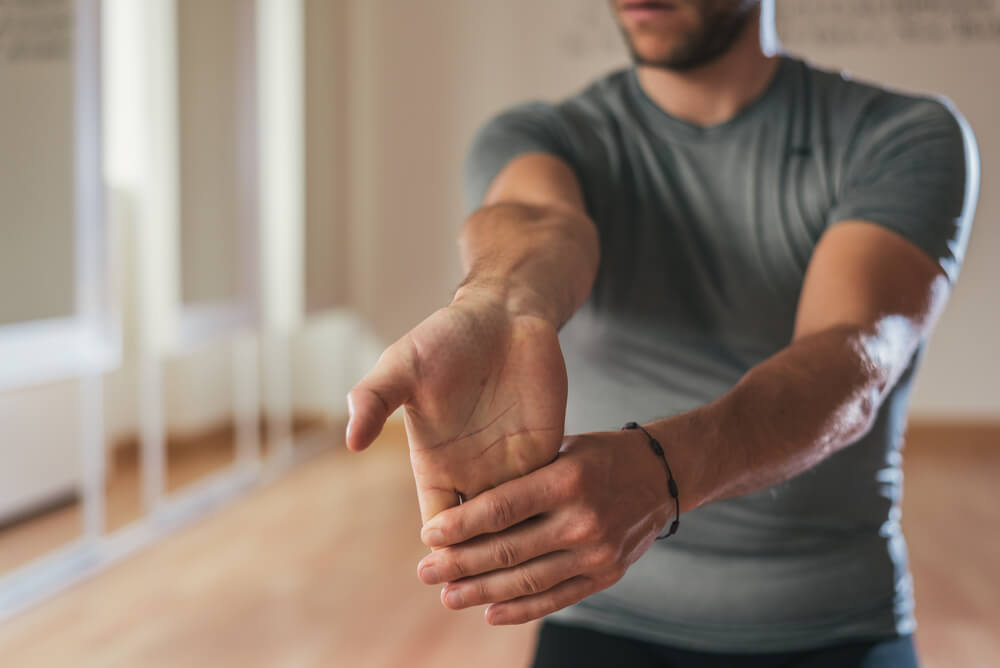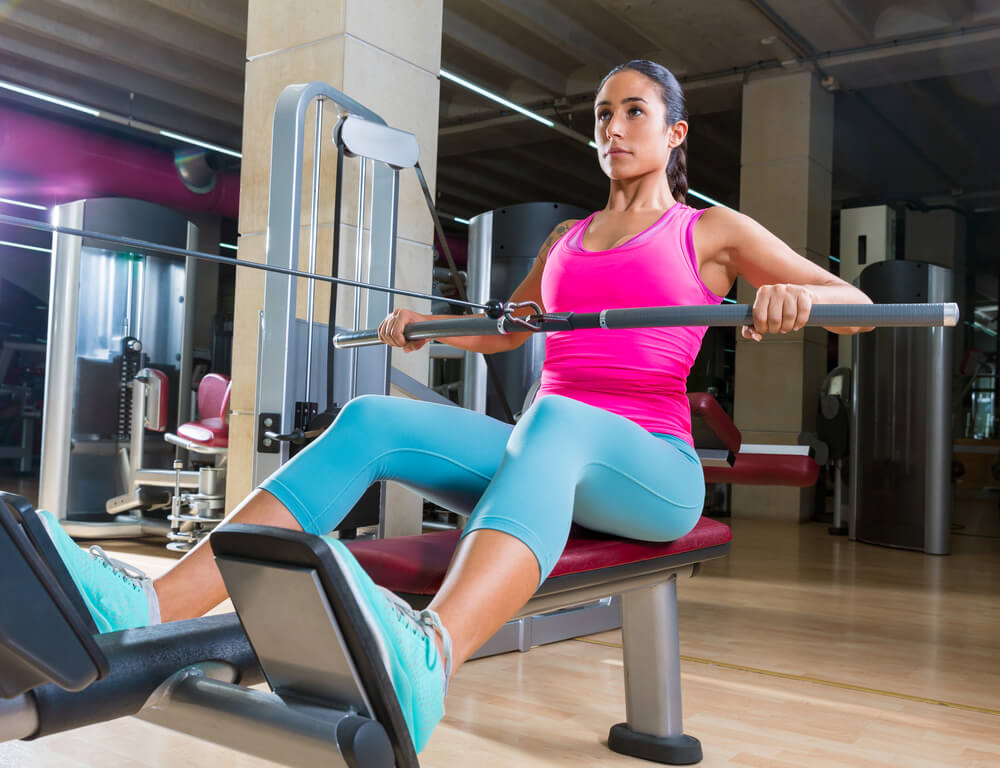
Do you use weight lifting Straps? You probably should. Why? They can help you perform better in the gym. We tell you how to use them and what exercises they work best with.
Whether you are into bodybuilding, weightlifting, cross training or whatever it may be, a pair of wrist straps might just become your two best friends. They are used for various reasons and in many different situations.
That’s because there are many benefits to wrist straps and we’ll show you why.
What Exactly Are Wrist Straps?
If you’ve been to the free weights section of your gym, you may have seen people using wrist straps while doing deadlifts, shrugs or other exercises using the barbell or even dumbbells in some cases. Wrist straps go around the wrists and have an extra long hanging band that you would use to wrap around said weight bar or pull-up bar. They are usually made from leather, nylon or canvas.
If you feel you have more strength in your arms, chest, shoulders and back to do more reps and sets than your grip strength will allow you to do, then wrist straps might just be for you. The point of them is to take the focus off of your grip strength and put the focus on the larger picture.
You likely aren’t doing deadlifts because you want stronger hands, right?
It is safe to guess that your answer is “No.” The purpose of a deadlift is to build strength and/or size in muscles like the glutes, quads, and back.
Do you also do shoulder shrugs to increase forearm strength?
Again, you most likely don’t do them for that reason.
So, what if you know you can go longer, but it’s your grip that gives out first?
Wrist straps will allow you to do go longer.

Isn’t Using Wrist Straps Considered Cheating?
The only place wrist straps are not allowed is in a powerlifting competition. Otherwise, there are no strap police at the gym and quite honestly, they are a pretty common accessory around most gyms because they do allow you to focus more on the goal at hand (no pun intended). So, unless you’re competing for a title, go ahead and use them.

Will You Get A Weakened Grip By Using Weight Lifting Straps?
If your grip is slipping and giving out before you’ve completed your target amount of reps during an exercise and you are prevented from finishing them, then chances are you may already have a weak grip. The good news is that there are plenty of grip strengthening and forearm exercises to do to fix that issue without inhibiting your big lifting session by opting out of using wrist straps.
Also, if you feel your grip is only giving out on the second or third set of an exercise, exclude the straps until your grip fatigues. If you find your grip is weaker on the heavier sets, then include the straps for those sets only. There are plenty of ways to find what works for you, just take note of where your grip weakness is and go from there.
What Are The Best Kind Of Wrist Straps To Buy?
Do not use the cheapest wrist straps you can find! You definitely want to make sure that you buy a good quality set of wrist straps. The best way to do this is to look at the specs, reviews and to ask other people who lift what they prefer and why.
You’ll want to make sure that the weight limit will actually hold more than what you know you can lift.
Why?
Simple, because if for some reason your straps give out during say, a shoulder shrug, that’s going to be nothing but bad news. You might also want to make sure that the comfort level and size suits you so it may be best to go to a store so you can try them in person.
They Come In Three Main Styles
There are three main styles of wrist straps that you should be aware of when choosing yours. They are the loop straps, speed straps, and hook straps.
Loop straps are one solid piece that wraps around your wrist and back through a loop in the end of the strap, which tightens securely around your wrist. They are easy to use and come in various lengths.
Speed straps, or Olympic straps, are closed loop straps that make for a quicker wrap to the bar. But, these are shorter and can’t be adjusted to fit tightly on the wrists, nor do they give you much length to wrap the bar more than once or twice.
Hook straps secure tightly to your wrists and can usually be adjusted to size. However, instead of having a hanging strap that you would wrap around the bar, they come equipped with a short hook that grabs the bar. The downfall to using this type of strap is that it prevents you from gripping the bar properly and performing certain lifts correctly. This is one of the less popular types of wrap as they are not very comfortable.
How Do I Use Wrist Straps?
It may seem like a pain at first, but using wrist straps can become second nature once you get the hang of things.
Depending on which type of straps you have, securing them to your wrists will either involve a slip on, a loop and pull or even a fastening system. Make sure that after you’ve safely secured them to your wrist that the long strap is hanging down on the inside of your wrist (along the palms of your hands).
This Is How To Secure Them To The Bar Or Bars
Wrap the ends of the straps around the bar/bars starting under the bar from back to front. Then, wrap the strap over the top and then under again. You can also use a figure 8 wrap as some weightlifters prefer to do.
Put your hands over the straps to hold them in place. This is also where you’ll need to make sure that you have a comfortable grip. If not, rewrap them until you do. Roll the bar/bars towards you until the straps are tight and pull on your wrists.
This Is How To Perform A Lift Or Pull While Using The Straps
No matter which type of pulling or lifting exercise you are doing while using the straps, make sure that you are not just letting your wrists take all of the weight. You need to keep your grip tight.
You should be using your wrists to assist you in maintaining your grip on the bar, but not to take the entire weight of it as this can cause wrist pain and injury.

These Are A Few Exercises You Can Do While Using Weight Lifting Straps
Now that you know what wrist straps are, have found the perfect set of straps and know how to wear them and use them, it’s time to get started on some exercises. Be sure to take precautions. Check your form, and choose the amount of weight that you can lift safely. Get your workout straps on and let’s go!
Barbell Row
Barbell rows are a full body compound exercise. The target muscles worked in barbell rows are in the back and arms including the lats, rhomboids, traps, deltoids and biceps. The glutes, triceps, and hamstrings act as stabilizers during a barbell row.
To begin, the barbell should be on the floor. Walk up to the barbell and step under the bar to the center of your feet. Bend at the waist and grab the bar with an overhand grip. Your hands should be a little wider than shoulder-width apart. Keep the back neutral or slightly arched, but not rounded, to prevent compression on the discs in the spine.
Position your chest so that it is parallel to the floor and your head is neutral. Bend your knees slightly and, taking a deep breath, grip the bar firmly and tense up your back muscles. As you exhale, slowly pull the bar up to your chest (in line with your sternum), bending your elbows, and engaging your upper back, lats and everything in between. Return to the starting position by slowly lowering the bar down over the center of your feet.
Barbell Shrugs
Shrugs are a very effective isolation exercise. Although they are sometimes called shoulder shrugs they actually target the trapezius muscle that extends from the center of your back at the middle of your spine to the posterior of your neck and the rhomboids, which are between your spine and your shoulder blades. The stabilizer muscles used during a shrug exercise are the erector spinae and the deltoids.
Stand holding the barbell with an overhand grip with your hands slightly wider than shoulder-width apart. Keep your arms straight, back neutral and feet hip-width apart. Avoid leaning forward or backward. Pull the bar up straight by raising your shoulders towards your ears and keeping your wrists straight, not bent. As you pull, avoid using a jerking motion. Pull smoothly and return to starting position by letting your shoulders drop back down to neutral.
Deadlifts
Deadlifts are a great strength exercise that will work many muscle groups such as the back, glutes, and legs. It is extremely important to perform a deadlift with proper form and use all safety precautions to avoid injury, especially in the lower back.
Start with the bar on the floor. Step up to the bar and make sure your feet are under the bar about half way. Your feet should be hip-width apart. Hinge at your hips and grab the bar with an overhand grip. Your hands should be about shoulder-width apart. Bend at the knees until your shins touch the bar. Do not roll the bar. Keep it right over the center of your feet. Lift your chest (don’t move the bar at this time), straighten your back and avoid dropping the hips.
Take a deep breath, pull the bar and stand up while still holding the breath. This causes your core to stay tight. Keep the bar against your legs and don’t shrug, lean or arch your back. After you’ve come to a full standing position, lock your knees and hips, and pull your shoulders tight. Return to the starting position by reversing the order and paying close attention to keeping your back straight.
Rack Pulls
Rack pulls are similar to deadlifts except there is a smaller range of motion during the exercise. The major muscles being worked during a rack pull are the glutes, hamstrings, forearms and the entire back.
Start with the bar on the rack. The height should be set to just below the knees. Walk up to the bar to where your feet are underneath about midway. Hinge at the hips and grab the bar with an overhand grip. Keep your back straight, hips pushed back and knees slightly bent. Face your head forward, take a deep breath and extend through the hips and knees pulling the bar upwards with straight arms until your knees lock, hips are straight and shoulders are back. Return to the starting position.
Conclusion
Whether you are completely against using wrist straps or all for them, you might find that there are many pros that go along with including straps in your lifting sessions. You will be able to pay better attention to the target muscle groups you are working rather than focusing on the strength, pain or the slip of your grip.
There are many ways to strengthen your grip and eventually eliminate the need for straps altogether by doing exercises such as squeezing the torsion grippers, doing the farmers walk with heavy dumbbells or kettlebells, performing push-ups from the fingertips, or throwing a pair of fat grips on your dumbbells or pull-up bar, which will increase the strength of your open grip as well. So until you work up to the grip strength you desire, there’s no shame in giving the straps a try. Be smart, stay safe and go lift!
By Heather Neff, CPT
Latest posts by Terry M (see all)
- Garage Gyms - Aug 1, 2018
- Kettlebells – Why They Should Be Added To Your Routine. - Jul 24, 2018
- Weight Belts: What Are They Really For? - May 31, 2018









